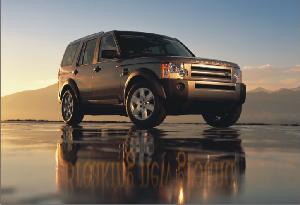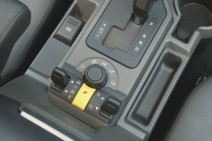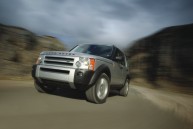 It's big, hard and heavy, but the new Land Rover also has a soft side
It's big, hard and heavy, but the new Land Rover also has a soft side
Land Rover claims to have built the best 4x4 on the market. The aura that surrounds the legendary Defender as one of the best off-road vehicles ever has spread through the whole product range, from the little Freelander to the luxurious Range Rover. This array of Rover models in this segment reveal that the years in which you only needed a 4x4 to get to your destination no matter what the terrain, without asking for much comfort or caring about your image, have long gone.
Nowadays the owner of a 4x4 prefers to order leather seats rather than an extra differential or alloy wheels instead of off-road tyres. Statistics show that more than 90 percent of 4x4s will hardly ever leave the comfortable road network.
But, for those who are still passionate about taking a trip on the wild side, there is still hope. With the launch of the new Discovery 3 from Land Rover, someone doesn't have to sacrifice their ego or comfort for the sake of off-road performance.
Interior
 The cabin was the starting point for the creation of the Discovery 3. Entering the car you have the feeling of not being able to control the monster. The car is big and feels big. But as soon as you get on the road, you discover that is also boasts a friendly side. Large rear view mirrors, excellent driving position and the unbeatable comfort of the air suspension are all there to make the journey a pleasure.
The cabin was the starting point for the creation of the Discovery 3. Entering the car you have the feeling of not being able to control the monster. The car is big and feels big. But as soon as you get on the road, you discover that is also boasts a friendly side. Large rear view mirrors, excellent driving position and the unbeatable comfort of the air suspension are all there to make the journey a pleasure.
The vehicle can be specified with either two or three rows of seats, giving space for up to seven adults. A special 'stadium seating' display of the seats means that each row is higher than the one in front, improving the view for all passengers.
Extensive storage space is a priority in a vehicle that prides itself on its exceptional practicality and versatility. In the dashboard, there are two glove compartments on the passenger side, and a tray at the base of the front console, which is very useful and easy to reach.
The use of an electronic park brake, rather than a conventional handbrake, liberates extra space in the central console. A large cubby hole with a cooling system can hold up to four cans for drinking. In all, 17.5 litres of drinks can be stored in special spaces.
The dashboard has a simple and geometric look. It resembles the Range Rover, with its clear vertical and horizontal lines, which give it a sleek and architectural design. There is also large instrumentation, plus well-sized, tactile and intuitive controls. Switches are kept to a minimum while the built-in technology, including Land Rover's new Terrain Response system, can do much of the work for the driver.
I was mentioning earlier the enormous change in customer demand for an off-road car. This includes new design features that were unimaginable in the almost military personnel carrier-format ten years ago.
Air conditioning is standard on all models. As an “exotic” feature, there is an additional lap cooler vent for the driver beneath the steering wheel.
The Discovery 3 offers a high level of in-car entertainment systems and one of the most advanced navigation systems available. Six speakers are fitted to entry models, to a premium 14-speaker harman/kardon 'Logic 7' seven-channel digital surround. Voice recognition is an option for navigation and audio controls.
The optional navigation system is DVD-based, with a seven inch high resolution touch screen and includes the latest generation of off-road navigation, unfortunately the maps for Romania are still unavailable.
Exterior
 The first impression when looking at the car is that of classic elegance. Simple and contemporary surfaces combine Land Rover's signature straight lines with modern trends. The Discovery resembles more than ever, both outside and inside, its luxurious brother the Range Rover.
The first impression when looking at the car is that of classic elegance. Simple and contemporary surfaces combine Land Rover's signature straight lines with modern trends. The Discovery resembles more than ever, both outside and inside, its luxurious brother the Range Rover.
The engineers of the Discovery tried to design the car from the inside-out, meaning the nature of the design derived from its purpose, to offer maximum cabin space and versatility. The body is a combination of steel and aluminium. Unlike most bodies attached to separate platforms, the Discovery 3 body is a key part of the structure. At the core of the on-road and off-road dynamics is the all-new Integrated Body-frame, a Land Rover patented technology.
The Discovery 3's body is manufactured like a conventional monocoque. It carries the body and the suspension, it encloses and protects vital electronic and mechanical systems and it provides a stable platform for the vehicle's many electronic controls.
The roof structure can accommodate both sun-roof and alpine roof. The alpine roof is a large, full width glass roof bonded into the metal structure, above the second and third-row seats.
Lightweight magnesium alloy is used for a section of the front structure and forms part of the front crash crumple zone. The bonnet, a characteristic Land Rover clamshell design, is aluminium. All four doors are made of steel; they have boron steel-reinforced side intrusion beams to improve impact performance.
Both bumpers have energy absorbing elements to protect vital components in low speed impacts normal both in city and off-road driving. The headlamp lenses are moulded into damage-resistant polycarbonate.
Technology
Two engine choices are offered in Romania on the Discovery 3, a Jaguar-derived 4.4-litre petrol V8 and a TDV6 turbo diesel.
The TDV6 turbo diesel was the engine that equipped the test dive car and I can tell you that it has no problem with moving three tons of steel in a very satisfactory manner. Engineers at Land Rover tried to make one of the most sophisticated diesel engines in the world.
They managed to convince me, as the sound of the engine is practically nonexistent inside the car in normal driving conditions, and the torque of 445 Nm @ 1900 rpm pushes you gently into the seat.
The new high-technology TDV6 turbo diesel for the Discovery 3 is a sister engine to that recently launched in the Jaguar S-Type, to great acclaim.
The unit uses common rail technology and operates at an even higher pressure than most common rail injection systems: about 25 per cent greater than average benefiting performance, economy, refinement and emissions. The average consumption shown by the computer in Bucharest traffic was 14 l/100km, which is more than reasonable for a three-ton car.
For the Discovery 3, petrol engine vehicles come exclusively with the advanced, six-speed ZF automatic transmission. For TDV6 models, there is a choice of this automatic or a six-speed manual gearbox. Very practical in day-to-day use in its automatic mode, the gearbox analyses road conditions and each individual's unique driving style, automatically tuning its response accordingly.
The offer of differentials will please many off-road aficionados.
The two-speed transfer box features an easy-to-use electronic shift, to move into low range (for off-road) or high range (for on-road).
For added traction, the centre differential is locked electronically when conditions require.
A lockable centre differential is a feature offered only on serious off-roaders and enables the vehicle to crawl, at low speed, over difficult terrain with more stability and less slip.
An electronically-controlled locking rear differential is also available with Terrain Response.
Testing
The Discovery 3 has gone through one of the toughest and most varied testing programmes of any vehicle ever offered for sale. It has been put through its paces over four million miles on five continents, in conditions as varied as the Nürburgring race circuit in Germany and the sand dunes of Dubai. It has been tested to extreme in the Australian outback, been punished on military off-road tracks in both Southern Africa and England, been driven at minus 40ºC on frozen lakes in northern Canada, and undertaken 12 weeks of almost non-stop testing at maximum speed on the Nardo test track in Italy.
The Discovery 3 is able to wade in water 700mm deep, climb and descend 45 degree gradients, remain stable when driving across a 35 degree slope, and operate in temperatures as extreme as minus 40ºC and plus 50ºC. The handbrake is capable of holding the vehicle on a 45 degree slope. Get a grip on that.
High-speed testing was also carried out where on-road handling and braking performance were pushed to the limit.
Discovery 3 test vehicles circulated continuously for 20 hours a day at, or near, maximum speed.
City driving will naturally form a large part of the real-world use of the Discovery 3. Tokyo, notorious for traffic, humidity and pollution, was used to test the vehicle's ability in stop-start traffic and the efficacy of the air conditioning system.
Knowing that the car passed all these tests will be very reassuring for someone planning to use the vehicle in Romania, where the streets take no prisoners.